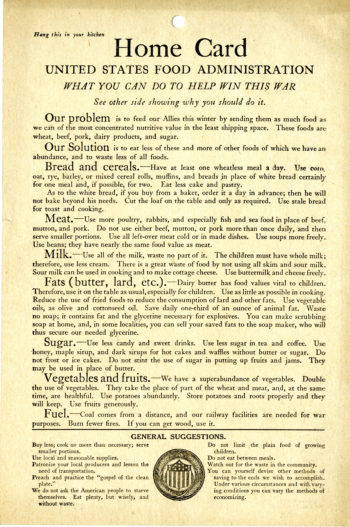
WWI Collections: Wartime Recipes from the Gellhorn Papers

Looking for some new and unusual recipes to try this fall? You might find some unexpected inspiration in Washington University Archives’ WWI collections. Edna Gellhorn, a civic leader, reformer, and St. Louis native, was very involved in the Women’s Central Committee on Food Conservation during the war, and her papers contain a wealth of resources that teach homemakers how to cook with unusual ingredients so that more food could be sent to the Allies overseas.
Asking Cooks to Conserve
The card on the right, designed to be hung in private kitchens, explains to citizens which foods they should conserve and why. Food rationing was entirely voluntary in America during WWI, and a strong media campaign of posters, recipe pamphlets, and live cooking and canning demonstrations was largely successful in encouraging Americans to do their part. This card asks homemakers to use less wheat, beef, pork, animal fats, dairy products, and sugar and explains what substitutions they can use for each.
Substituting Cheese for Meat
Although some dairy products, like whole milk, cream, and butter, needed to be conserved, cottage cheese was made from sour milk, which might otherwise have been wasted, and citizens were encouraged to use it freely as a substitute for meat proteins. The pamphlet below shares a wide variety of interesting recipes using cottage cheese. Cottage cheese and peanut butter soup, anyone?


True Patriots Waste Nothing
A big part of the Food Administration’s campaign to conserve food for the troops involved not wasting anything edible. The following flyer urges Missouri residents to use parts of the animal that would normally be thrown out, such as the brains, kidneys, and tongues.

Going Without Sugar
France, Belgium, Italy, and England were dealing with dramatically reduced supplies of sugar during the war. To increase the amount of sugar we sent overseas while still preserving enough for local canning efforts, the United States Food Administration urged Americans to use substitutes like honey and corn syrup in their cooking. The following flyer gives a few recipes for popular holiday cranberry dishes made without sugar.

Finding Substitutes for Wheat
Wheat was also in short supply during the war, and citizens were urged to use corn, oat, rye, or barley instead of wheat or white bread for at least one meal a day. The pamphlet below has recipes for cornflour cookies, waffles, cakes, and other popular baked goods.

Pickling and Canning
Fresh vegetables and fruits were difficult to ship overseas, and so Americans were encouraged to eat them in abundance to facilitate cutting back on meat and wheat products. Many Americans started “War Gardens” to grow their own fruits and vegetables, and the excess was either pickled or canned. Below are recipes for pickling corn, tomatoes, cabbage, and even fruit. You can also read more about canning efforts during the war in our previous blog post on the Gellhorn Papers.

Resources on WWI
Letters from the Gellhorn Papers and other materials from Washington University’s WWI collections are now available digitally through the Missouri Digital Heritage project, “Missouri Over There: Missouri and the Great War,” a project to digitize collections of Missouri’s participation in the First World War. You can check out the project at Missouri Over There.
Patrons interested in researching more about WWI can also view the library’s WWI Archival Sources finding aid to discover other related University collections.

